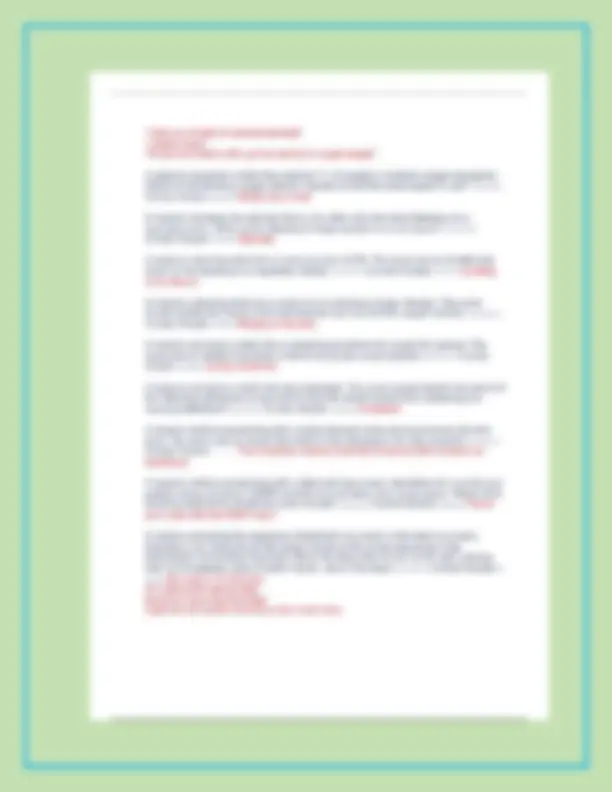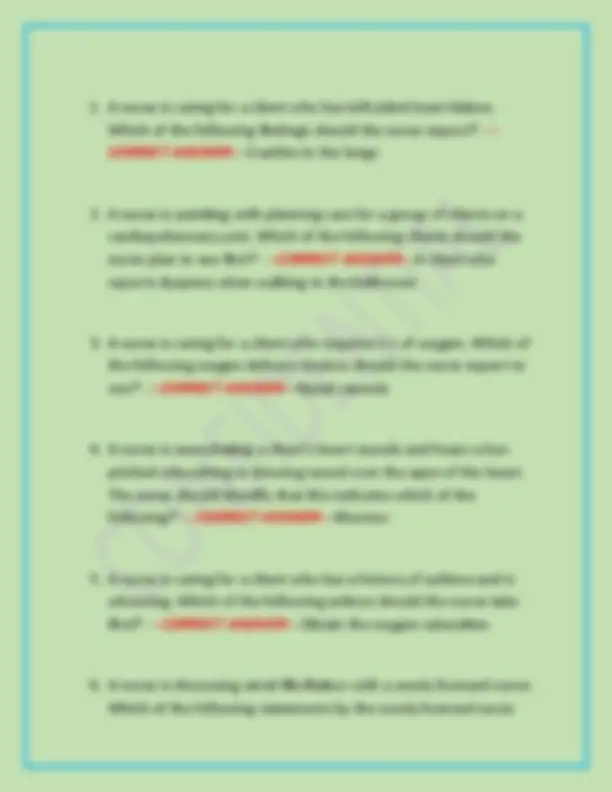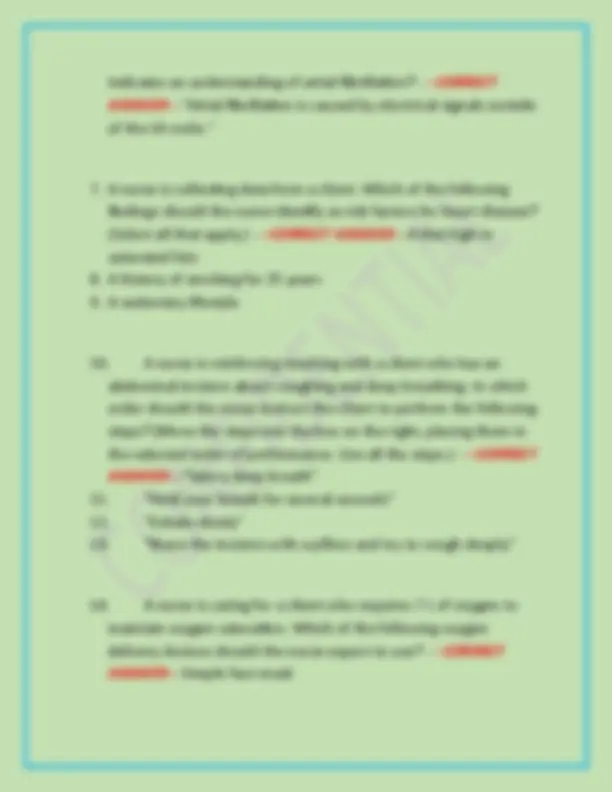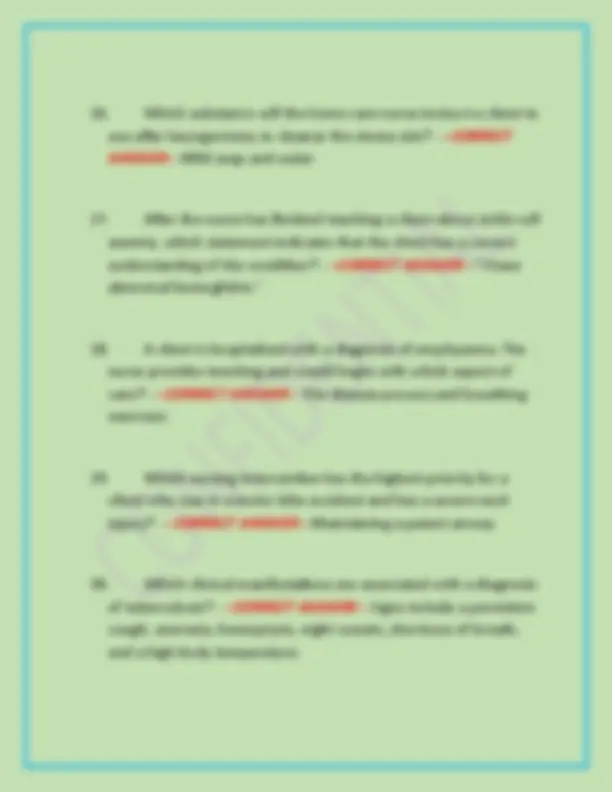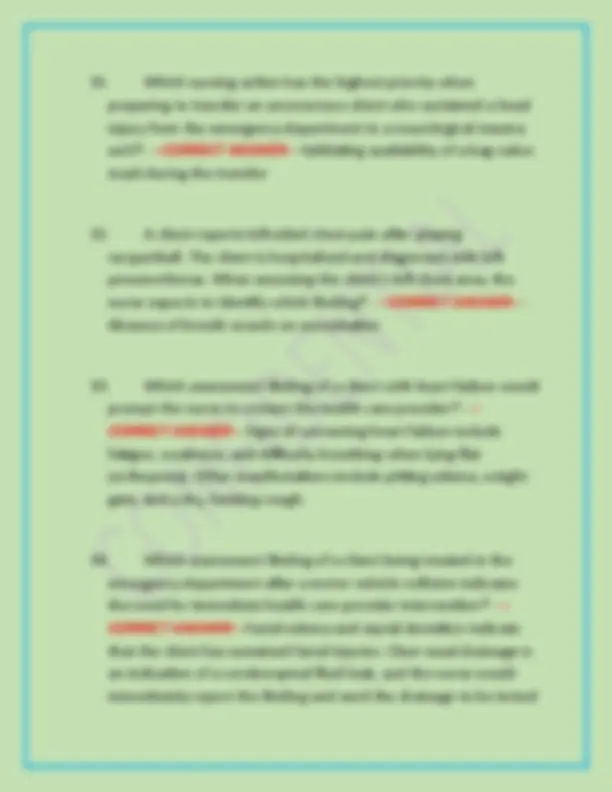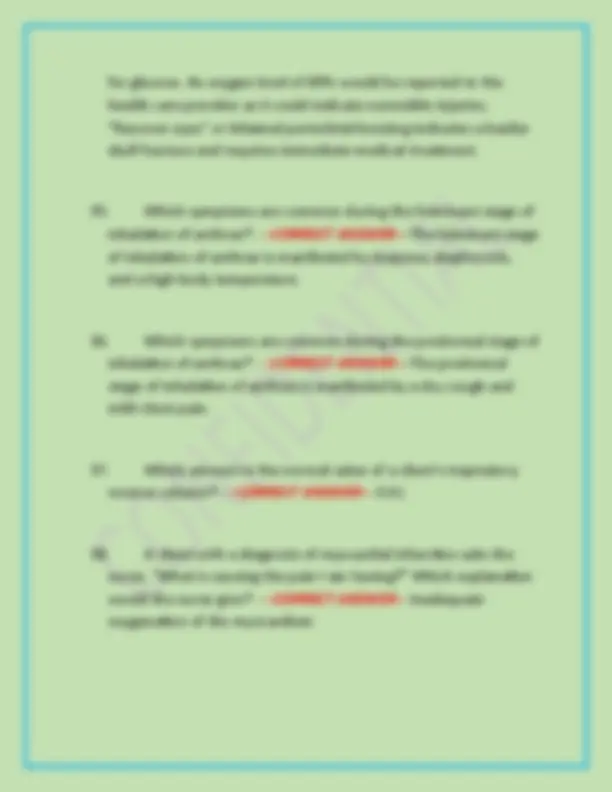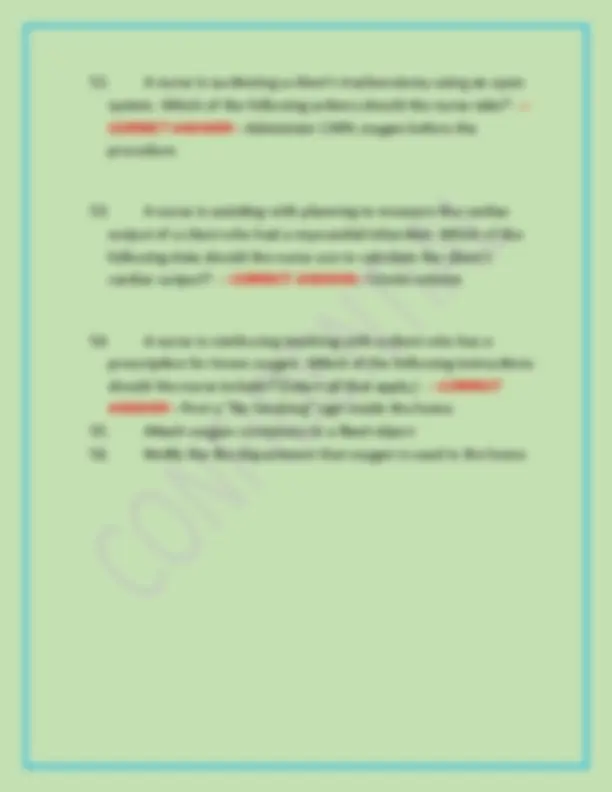Download ATI GAS EXCHANGE AND OXYGENATION EXAM – VERIFIED LATEST VERSION WITH 100% CORRECT QUESTION and more Exams Nursing in PDF only on Docsity!
ATI GAS EXCHANGE AND
OXYGENATION EXAM – VERIFIED
LATEST VERSION WITH 100%
CORRECT QUESTIONS &
ANSWERS|2025 A+ GRADED EXAM
- A nurse is caring for a client who has left-sided heart failure. Which of the following findings should the nurse expect? - -- CORRECT ANSWER-- - Crackles in the lungs
- A nurse is assisting with planning care for a group of clients on a cardiopulmonary unit. Which of the following clients should the nurse plan to see first? - --CORRECT ANSWER-- - A client who reports dyspnea when walking to the bathroom
- A nurse is caring for a client who requires 1 L of oxygen. Which of the following oxygen delivery devices should the nurse expect to use? - --CORRECT ANSWER-- - Nasal cannula
- A nurse is auscultating a client's heart sounds and hears a low- pitched whooshing or blowing sound over the apex of the heart. The nurse should identify that this indicates which of the following? - --CORRECT ANSWER-- - Murmur
- A nurse is caring for a client who has a history of asthma and is wheezing. Which of the following actions should the nurse take first? - --CORRECT ANSWER-- - Obtain the oxygen saturation.
- A nurse is discussing atrial fibrillation with a newly licensed nurse. Which of the following statements by the newly licensed nurse
indicates an understanding of atrial fibrillation? - --CORRECT ANSWER-- - "Atrial fibrillation is caused by electrical signals outside of the SA node."
- A nurse is collecting data from a client. Which of the following findings should the nurse identify as risk factors for heart disease? (Select all that apply.) - --CORRECT ANSWER-- - A diet high in saturated fats
- A history of smoking for 25 years
- A sedentary lifestyle
- A nurse is reinforcing teaching with a client who has an abdominal incision about coughing and deep breathing. In which order should the nurse instruct the client to perform the following steps? (Move the steps into the box on the right, placing them in the selected order of performance. Use all the steps.) - --CORRECT ANSWER-- - "Take a deep breath"
- "Hold your breath for several seconds"
- "Exhale slowly"
- "Brace the incision with a pillow and try to cough deeply"
- A nurse is caring for a client who requires 7 L of oxygen to maintain oxygen saturation. Which of the following oxygen delivery devices should the nurse expect to use? - --CORRECT ANSWER-- - Simple face mask
ANSWER-- - Listen for a hollow sound when performing chest percussion therapy.
- Soft swishing sounds of breathing are heard when the nurse auscultates a client's chest. Which term would be used when documenting this assessment finding? - --CORRECT ANSWER-- - Vesicular breath sounds
- Which is the cause of frequent upper respiratory tract infections in toddlers? - --CORRECT ANSWER-- - Immature immune system
- The nurse noticed the respiratory rate as regular and slow while assessing a client. Which would be the condition of the client? - --CORRECT ANSWER-- - Bradypnea
- Which disease is caused by coronaviruses? - --CORRECT ANSWER-- - Severe acute respiratory syndrome
- A chronically ill, older client lives with their daughter. The client reports the daughter, who has three small children, seems run-down, coughs a lot, and sleeps all the time. Which statement supports the need for the nurse to pursue the daughter's condition as a potential case finding? - --CORRECT ANSWER-- - Older adults with chronic illness are more susceptible to tuberculosis.
- Which substance will the home care nurse instruct a client to use after laryngectomy to cleanse the stoma site? - --CORRECT ANSWER-- - Mild soap and water
- After the nurse has finished teaching a client about sickle cell anemia, which statement indicates that the client has a correct understanding of the condition? - --CORRECT ANSWER-- - "I have abnormal hemoglobin."
- A client is hospitalized with a diagnosis of emphysema. The nurse provides teaching and would begin with which aspect of care? - --CORRECT ANSWER-- - The disease process and breathing exercises
- Which nursing intervention has the highest priority for a client who was in a motor bike accident and has a severe neck injury? - --CORRECT ANSWER-- - Maintaining a patent airway
- Which clinical manifestations are associated with a diagnosis of tuberculosis? - --CORRECT ANSWER-- - Signs include a persistent cough, anorexia, hemoptysis, night sweats, shortness of breath, and a high body temperature.
for glucose. An oxygen level of 89% would be reported to the health care provider as it could indicate nonvisible injuries. "Raccoon eyes" or bilateral periorbital bruising indicates a basilar skull fracture and requires immediate medical treatment.
- Which symptoms are common during the fulminant stage of inhalation of anthrax? - --CORRECT ANSWER-- - The fulminant stage of inhalation of anthrax is manifested by dyspnea, diaphoresis, and a high body temperature.
- Which symptoms are common during the prodromal stage of inhalation of anthrax? - --CORRECT ANSWER-- - The prodromal stage of inhalation of anthrax is manifested by a dry cough and mild chest pain.
- Which amount is the normal value of a client's inspiratory reserve volume? - --CORRECT ANSWER-- - 3.0 L
- A client with a diagnosis of myocardial infarction asks the nurse, "What is causing the pain I am having?" Which explanation would the nurse give? - --CORRECT ANSWER-- - Inadequate oxygenation of the myocardium
- Which is the optimal area for the nurse to assess adequate tissue oxygenation in an African-American neonate? - --CORRECT ANSWER-- - Mucous membranes of the mouth
- A client takes morphine sulfate for severe metastatic bone pain. The nurse will assess the client for which adverse effect? - -- CORRECT ANSWER-- - Respiratory depression
- A nurse is assisting with the care of a client who has a chest tube. Which of the following actions should the nurse take? - -- CORRECT ANSWER-- - Monitor the client for subcutaneous emphysema.
- A nurse is collecting data from a client who is receiving oxygen therapy. The nurse should identify that which of the following findings can indicate oxygen toxicity? - --CORRECT ANSWER-- - Ringing in the ears
- A nurse is caring for a client who is receiving supplemental oxygen for hypoxia. The nurse should identify that which of the following can cause hypoxia? - --CORRECT ANSWER-- - Smoke inhalation
- A nurse is caring for a client who has atelectasis. The nurse should identify that which of the following substances is required
- A nurse is suctioning a client's tracheostomy using an open system. Which of the following actions should the nurse take? - -- CORRECT ANSWER-- - Administer 100% oxygen before the procedure.
- A nurse is assisting with planning to measure the cardiac output of a client who had a myocardial infarction. Which of the following data should the nurse use to calculate the client's cardiac output? - --CORRECT ANSWER-- - Stroke volume
- A nurse is reinforcing teaching with a client who has a prescription for home oxygen. Which of the following instructions should the nurse include? (Select all that apply.) - --CORRECT ANSWER-- - Post a "No Smoking" sign inside the home
- Attach oxygen containers to a fixed object
- Notify the fire department that oxygen is used in the home

